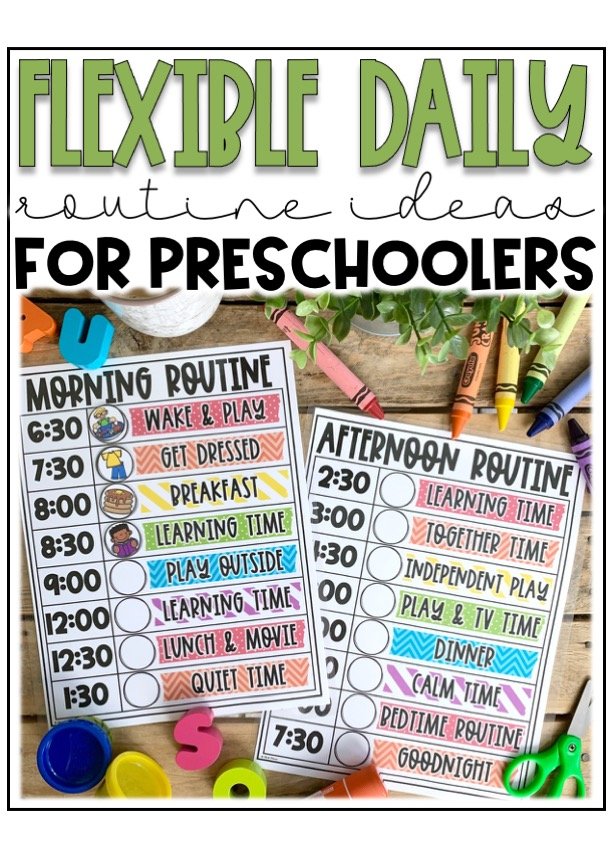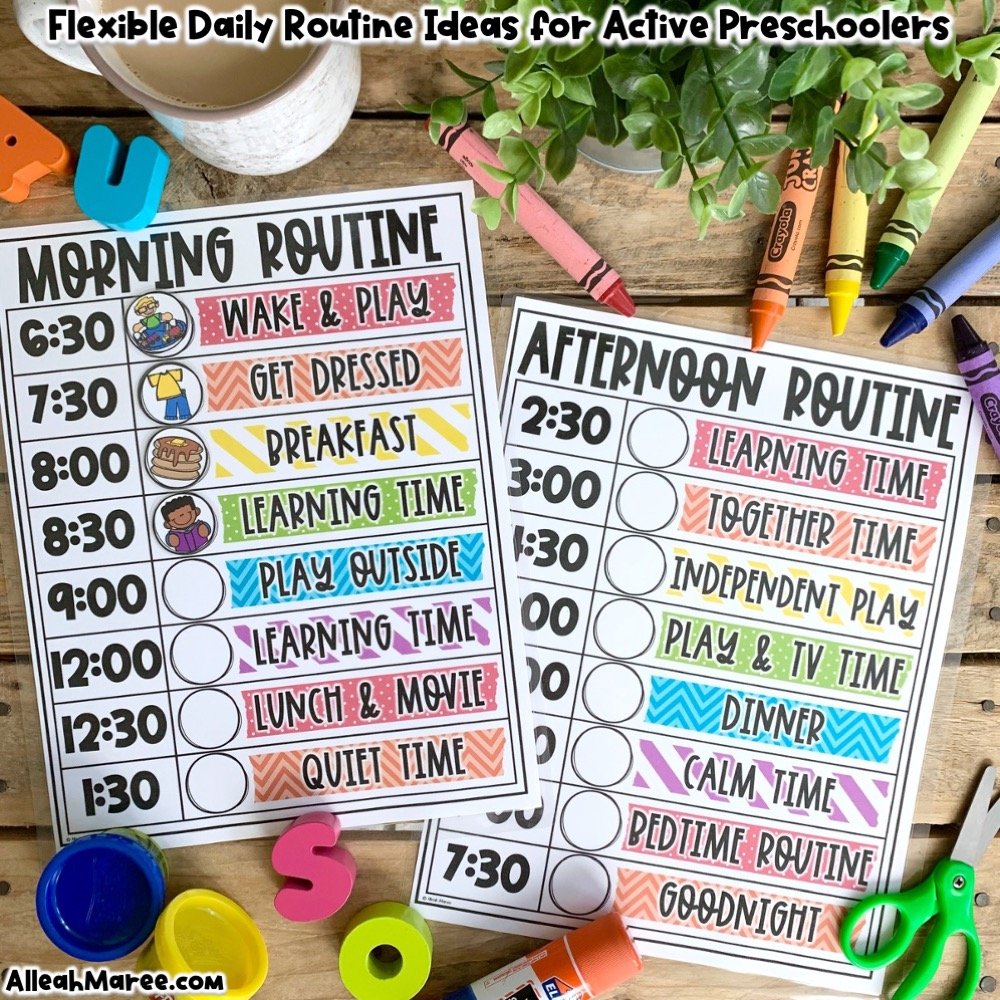Flexible Daily Routine Ideas for Active Preschoolers
Creating a daily routine for preschoolers is ESSENTIAL to successful learning times and behaviors. Young minds truly thrive when there is structure in place and most days offer some predictability. Kiddos find comfort in knowing what to expect from the day and what the boundaries are.
That being said, here are a few ideas and examples of what our daily routine looks like and a few tips to help you create a routine with your preschooler too.
IDEA #1: Make your routine specific to YOUR KIDS.
This is the most important thing to keep in mind when creating a daily routine or schedule…make it unique and specific to you and the kids you’ll be using it with. I’d HIGHLY recommend that you include things in your routine that are expected, enjoyable, and “normal” for your preschoolers. Include things that you do on all or at least MOST of your days together and then throw a few fun outings or events in there to keep things interesting. But, most importantly, be true to you and include things in your routine that make sense and feel good for your days.
Depending on if you’re creating a routine for a classroom full of preschoolers or for your own preschooler at home, they will include different things. If you’re in the classroom, you’ll want to include things like bathroom breaks, special classes, recess, and quiet times. If you’re at home, you’ll have a bit more freedom to incorporate walks outside or time with friends or a drive to a park nearby. Whichever kind of routine you need to create, just make sure it works for you and your kids and covers the most necessary activities. That’s the most important thing.
IDEA #2: Keep it flexible.
No matter how much detail you’ve planned out, there are always days that throw a big wrench in those plans. It can be hard to “go with the flow” when things aren’t going as expected, but having a few “back up plans” ideas ready in case the expected routine doesn’t happen is a great thing to practice. Try to stay flexible and go with it when things get messy!
Being flexible and emotionally mature enough to change routine sometimes is a great skill for preschoolers to practice as well. So, there’s always a learning opportunity, whether things are going as planned or not. :)
IDEA #3: Incorporate planned brain breaks.
You know best when your little ones need a break. You can see it on their faces and eventually in their behaviors too. Taking breaks is a perfect transition between activities or even in the middle of completing one activity when you notice they’re struggling to focus or are getting crabby. Planning those breaks into your day is a great strategy for keeping the routine moving along with fewer trip-ups.
So, take a break as often as you need to! Go outside for 5 minutes, do some jumping jacks, play a quick game, have a snack, watch a dance movie, or whatever quick activity y’all enjoy together! You could even incorporate some learning into your break time by doing a craft with a learning element or playing a game that practices some kind of academic skill. Whatever small thing allows you and your kiddos to relax their brains and move their bodies so they can refocus.
Check out these free videos from GoNoodle for easy brain breaks anywhere!
IDEA #4: Offer choices when you can.
Allowing learners to make choices helps them to feel a sense of contribution and control in their learning. I always recommend starting by limiting the choices to 2 or 3 options at a time. And, it’s smart to make sure the options all lead to the outcome you need it to be.
So, if you need to work on shapes, give them one or two shape activities to choose from. That way, when they pick one, they feel that they’ve decided they’re going to participate and that leads to a better attitude all around. By offering a choice, you’re giving them small amount of power and making them FEEL they have the final say. And, at the end of the day, you’re still accomplishing what you need to have done. :)
I use learner-friendly choice boards with Ethan to allow him to choose some of the activities we do throughout the day. I only include options I’m comfortable with him choosing and he feels good about getting to decide what he’s doing with his time. It’s a total win-win. :) You can grab free choice boards here!
IDEA #5: Use visual reminders throughout the day.
When teaching little ones, it’s always a good idea to use visual supports to reinforce what you’re telling them. Many preschoolers understand what you’re saying, but it can be helpful to solidify your words with visual cues too. Something like how “actions speak louder than words” or “a picture’s worth a thousand words”, using visuals to reinforce your point is always a good idea.
There are visual timers that use lights to show how much time is left on timers, you can give hand signals to remind how much time is left or as a quiet reminder to change a behavior, or you can hold up small picture cards to remind kiddos what’s expected. I’m a big fan of using visuals to communicate with little ones as much as possible. It’s an effective way to offer reminders and communicate expectations, while empowering them to make good choices.
You can grab the visual schedule we use every day HERE.
EXAMPLE OF OUR DAY
If I’m being honest, I totally want to squeeze in more learning times throughout our day. That’s a goal of ours for sure. At this point, we only REALLY get to completely maybe one real, “formal learning time” during the day since Ethan’s still only 3 and so much of our time is spent playing and exploring together.
The plan is that when he turns 4, that we ramp up the learning times throughout our days from 1 to at 2 and then from 2 to 3. This current schedule reflects the routine we are planning to grow into over the next 6 months. :)
6:30-7:30 - Wake up and play in room
7:30 - 8:00 - Get Dressed
8:00 - 8:30 - 30-minute show and Breakfast
8:30 - 9:00 - Learning Time (with built-in breaks when needed)
9:00 - 11:45 - Play Outside
12:00 - 12:30 - Learning Time (with built-in breaks when needed)
12:30 - 1:30 - Lunch and Movie
1:30 - 2:30 - Quiet Time
2:30 - 3:00 - Learning Time (with built-in breaks when needed)
3:00 - 4:30 - Play together
4:30 - 5:30 - Independent Play Time or TV Time
5:30 - Dinner
6:00 - 7:00 - Calm Play Time
7:00 - 7:30 - Bedtime Routine
7:30 - Goodnight!
Will your routine share any parts that ours has? Or do you do totally different things throughout the day? :)
OOOH! And if you need a few ways to establish your OWN routine, check out these free daily lists that you can edit to fit your own needs! They’re super helpful for me when I’m trying to keep track of all the things that need to be done in a week. :)
Anyway, I hope these examples and ideas of routines and daily schedules were helpful as you create your own routines and schedules at home or in your classroom! I’m always happy to help, so feel free to reach out if you have questions. :)
Cheering you on!
Wanna follow me on TPT? CLICK HERE!
Is Instagram more your thing? CLICK HERE!
To peek at my Facebook page, CLICK HERE!














